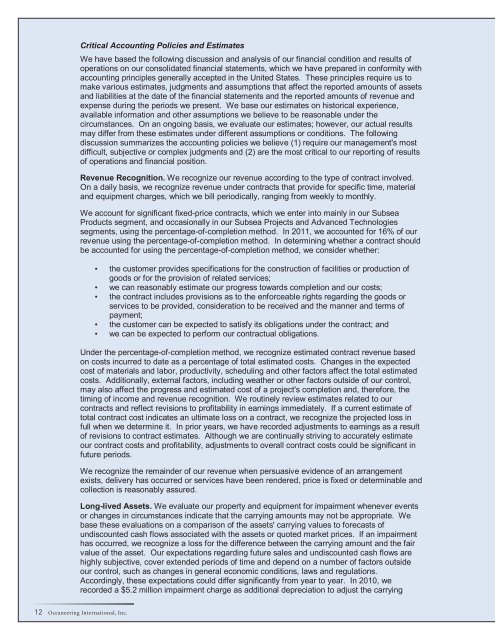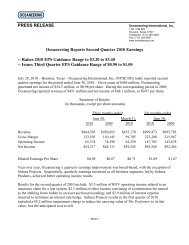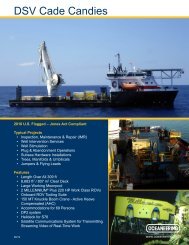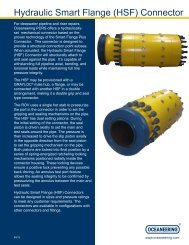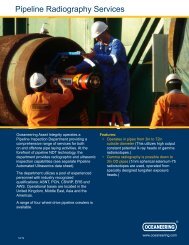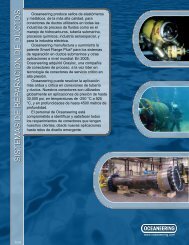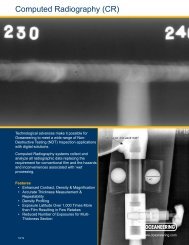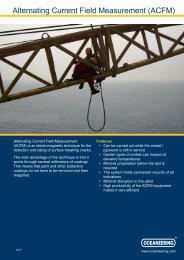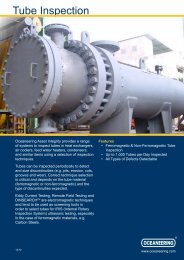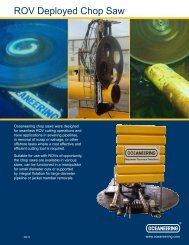Critical Accounting Policies and EstimatesWe have based the following discussion and analysis of our financial condition and results ofoperations on our consolidated financial statements, which we have prepared in con<strong>for</strong>mity withaccounting principles generally accepted in the United States. These principles require us tomake various estimates, judgments and assumptions that affect the reported amounts of assetsand liabilities at the date of the financial statements and the reported amounts of revenue andexpense during the periods we present. We base our estimates on historical experience,available in<strong>for</strong>mation and other assumptions we believe to be reasonable under thecircumstances. On an ongoing basis, we evaluate our estimates; however, our actual resultsmay differ from these estimates under different assumptions or conditions. The followingdiscussion summarizes the accounting policies we believe (1) require our management's mostdifficult, subjective or complex judgments and (2) are the most critical to our reporting of resultsof operations and financial position.Revenue Recognition. We recognize our revenue according to the type of contract involved.On a daily basis, we recognize revenue under contracts that provide <strong>for</strong> specific time, materialand equipment charges, which we bill periodically, ranging from weekly to monthly.We account <strong>for</strong> significant fixed-price contracts, which we enter into mainly in our SubseaProducts segment, and occasionally in our Subsea Projects and Advanced Technologiessegments, using the percentage-of-completion method. In 2011, we accounted <strong>for</strong> 16% of ourrevenue using the percentage-of-completion method. In determining whether a contract shouldbe accounted <strong>for</strong> using the percentage-of-completion method, we consider whether:• the customer provides specifications <strong>for</strong> the construction of facilities or production ofgoods or <strong>for</strong> the provision of related services;• we can reasonably estimate our progress towards completion and our costs;• the contract includes provisions as to the en<strong>for</strong>ceable rights regarding the goods orservices to be provided, consideration to be received and the manner and terms ofpayment;• the customer can be expected to satisfy its obligations under the contract; and• we can be expected to per<strong>for</strong>m our contractual obligations.Under the percentage-of-completion method, we recognize estimated contract revenue basedon costs incurred to date as a percentage of total estimated costs. Changes in the expectedcost of materials and labor, productivity, scheduling and other factors affect the total estimatedcosts. Additionally, external factors, including weather or other factors outside of our control,may also affect the progress and estimated cost of a project's completion and, there<strong>for</strong>e, thetiming of income and revenue recognition. We routinely review estimates related to ourcontracts and reflect revisions to profitability in earnings immediately. If a current estimate oftotal contract cost indicates an ultimate loss on a contract, we recognize the projected loss infull when we determine it. In prior years, we have recorded adjustments to earnings as a resultof revisions to contract estimates. Although we are continually striving to accurately estimateour contract costs and profitability, adjustments to overall contract costs could be significant infuture periods.We recognize the remainder of our revenue when persuasive evidence of an arrangementexists, delivery has occurred or services have been rendered, price is fixed or determinable andcollection is reasonably assured.Long-lived Assets. We evaluate our property and equipment <strong>for</strong> impairment whenever eventsor changes in circumstances indicate that the carrying amounts may not be appropriate. Webase these evaluations on a comparison of the assets' carrying values to <strong>for</strong>ecasts ofundiscounted cash flows associated with the assets or quoted market prices. If an impairmenthas occurred, we recognize a loss <strong>for</strong> the difference between the carrying amount and the fairvalue of the asset. Our expectations regarding future sales and undiscounted cash flows arehighly subjective, cover extended periods of time and depend on a number of factors outsideour control, such as changes in general economic conditions, laws and regulations.Accordingly, these expectations could differ significantly from year to year. In 2010, werecorded a $5.2 million impairment charge as additional depreciation to adjust the carrying12 <strong>Oceaneering</strong> International, Inc.
value of our vessel held <strong>for</strong> sale, The Per<strong>for</strong>mer, to its fair value less estimated costs to sell.We completed the sale in July 2010 <strong>for</strong> approximately the vessel's reduced carrying value.The Per<strong>for</strong>mer was included in our Subsea Projects segment, and the impairment and result ofits sale are included in the gross margin and operating income in the Subsea Projects segment.We charge the costs of repair and maintenance of property and equipment to operations asincurred, while we capitalize the costs of improvements that extend asset lives or functionality.Goodwill. We account <strong>for</strong> business combinations using the acquisition method of accounting,with the acquisition price being allocated to the assets acquired and liabilities assumed basedon their fair market values at the date of acquisition. In September 2011, the FinancialAccounting Standards Board ("FASB") issued an update regarding goodwill impairment testing.Under the update, an entity has the option to first assess qualitative factors to determinewhether the existence of events or circumstances leads to a determination that it is more likelythan not that the fair value of a reporting unit is less than its carrying amount. If, after assessingthe totality of events or circumstances, an entity determines it is not more likely than not that thefair value of a reporting unit is less than its carrying amount, per<strong>for</strong>ming the two-step impairmenttest is unnecessary. However, if an entity concludes otherwise, then it is required to per<strong>for</strong>mthe first step of the two-step impairment test. This update is effective <strong>for</strong> us January 1, 2012,and earlier adoption is permitted. We have elected to adopt this update early and apply it in2011. The provisions of the update have not had a material effect on our financial position orresults of operations. Prior to this FASB update, we tested the goodwill attributable to each ofour reporting units <strong>for</strong> impairment annually, or more frequently whenever events or changes incircumstances indicated that the carrying amounts may not have been appropriate. Weestimated fair value of the reporting units using both an income approach, which considers adiscounted cash flow model, and a market approach. For reporting units with significantgoodwill, we do not believe our goodwill will be impaired during 2012.Loss Contingencies. We self-insure <strong>for</strong> workers' compensation, maritime employer's liabilityand comprehensive general liability claims to levels we consider financially prudent, and beyondthe self-insurance level of exposure, we carry insurance, which can be by occurrence or in theaggregate. We determine the level of accruals <strong>for</strong> claims exposure by reviewing our historicalexperience and current year claim activity. We do not record accruals on a present-value basis.We review larger claims with insurance adjusters and establish specific reserves <strong>for</strong> knownliabilities. We establish an additional reserve <strong>for</strong> incidents incurred but not reported to us <strong>for</strong>each year using our estimates and based on prior experience. We believe we have establishedadequate accruals <strong>for</strong> uninsured expected liabilities arising from those obligations. However, itis possible that future earnings could be affected by changes in our estimates relating to thesematters.We are involved in various claims and actions against us, most of which are covered byinsurance. We believe that our ultimate liability, if any, that may result from these claims andactions will not materially affect our financial position, cash flows or results of operations.Income Taxes. Our tax provisions are based on our expected taxable income, statutory ratesand tax-planning opportunities available to us in the various jurisdictions in which we operate.Determination of taxable income in any jurisdiction requires the interpretation of the related taxlaws. We are at risk that a taxing authority's final determination of our tax liabilities may differfrom our interpretation. Our effective tax rate may fluctuate from year to year as our operationsare conducted in different taxing jurisdictions, the amount of pre-tax income fluctuates and ourestimates regarding the realizability of items such as <strong>for</strong>eign tax credits may change. In 2011,2010 and 2009, we recorded reductions of income tax expense of $0.9 million, $1.0 million and$0.3 million, respectively, resulting from a combination of expiring statutes of limitations and theresolution of uncertain tax positions related to certain tax liabilities we recorded in prior years.Current income tax expense represents either nonresident withholding taxes or the liabilitiesexpected to be reflected on our income tax returns <strong>for</strong> the current year, while the net deferredincome tax expense or benefit represents the change in the balance of deferred tax assets orliabilities as reported on our balance sheet.2011 Annual Report 13
- Page 3 and 4: Financial Highlights($ in thousands
- Page 5 and 6: In December we secured a three-year
- Page 7: 2011 Financial SectionOceaneering I
- Page 10 and 11: Oceaneering Common StockOur common
- Page 12 and 13: Management's Discussion and Analysi
- Page 16 and 17: We establish valuation allowances t
- Page 18 and 19: In 2009, we used $162 million in in
- Page 20 and 21: For 2011, our ROV revenue and opera
- Page 22 and 23: We earn equity income from our 50%
- Page 24 and 25: Controls and ProceduresDisclosure C
- Page 26 and 27: In our opinion, Oceaneering Interna
- Page 28 and 29: OCEANEERING INTERNATIONAL, INC. AND
- Page 30 and 31: OCEANEERING INTERNATIONAL, INC. AND
- Page 32 and 33: OCEANEERING INTERNATIONAL, INC. AND
- Page 34 and 35: for marine services equipment (such
- Page 36 and 37: segment and its Australian assets a
- Page 38 and 39: Revenue in Excess of Amounts Billed
- Page 40 and 41: elationship and, if it is, the type
- Page 42 and 43: December 31,(in thousands) 2011 201
- Page 44 and 45: in entities or jurisdictions that h
- Page 46 and 47: 4. SELECTED BALANCE SHEET AND INCOM
- Page 48 and 49: On January 6, 2012, we entered into
- Page 50 and 51: Financial Instruments and Risk Conc
- Page 52 and 53: The table that follows presents Rev
- Page 54 and 55: The following table presents Assets
- Page 56 and 57: Geographic Operating AreasThe follo
- Page 58 and 59: equirements. The Compensation Commi
- Page 60 and 61: in 2011, 2010 and 2009 were subject
- Page 62 and 63: Forward-Looking StatementsAll state
- Page 64:
Oceaneering International, Inc.1191


